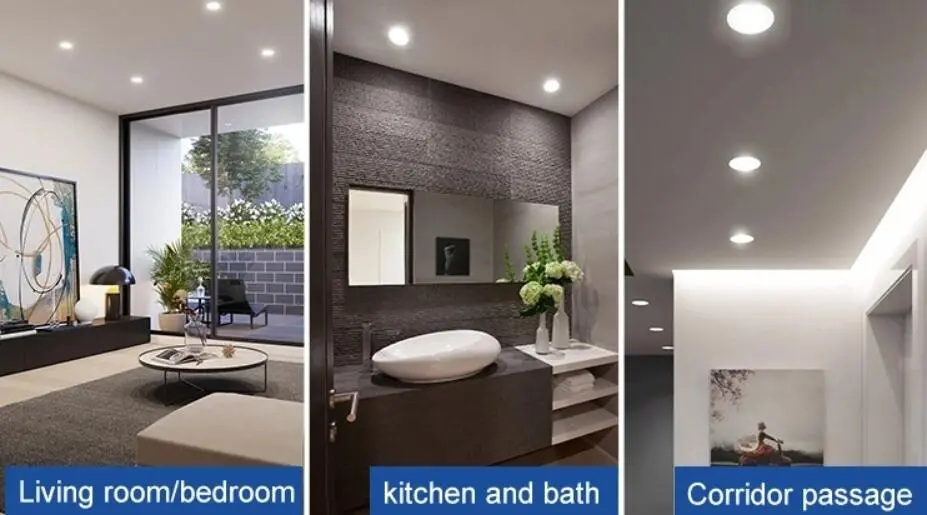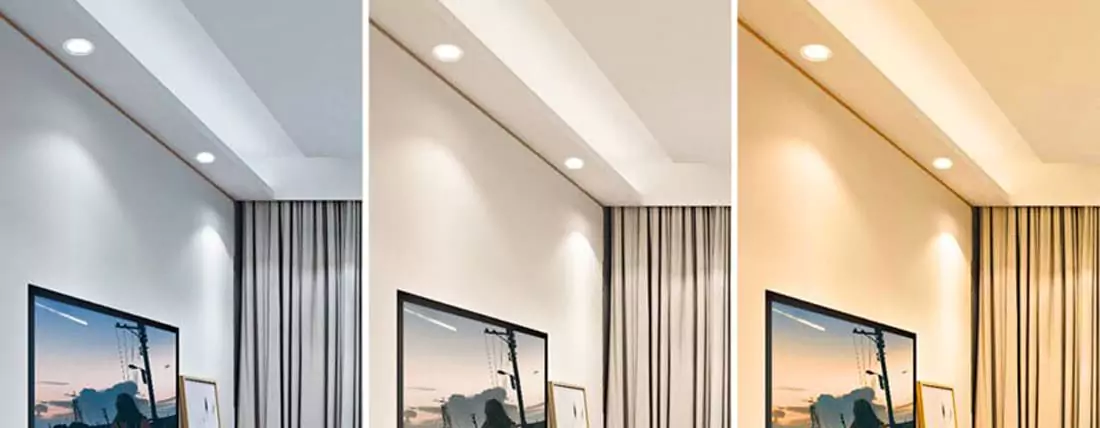Choosing the right led lights for bedroom is crucial in creating a space that is both functional and inviting. Bedroom lighting is more than just a necessity; it plays a key role in setting the mood, enhancing comfort, and facilitating various activities, from reading to relaxing. The right lighting fixtures can transform your bedroom into a serene sanctuary or a vibrant, stylish retreat.
In this guide, we’ll explore the different types of lighting fixtures available and help you determine the best options for your bedroom, whether your focus is on functionality, ambiance, or aesthetics.
Assess Your Bedroom’s Lighting Needs
Before choosing specific fixtures, it’s important to assess your bedroom’s lighting needs based on the room’s layout, size, and purpose. Consider the following key factors:
1. Ambient Lighting: This is the primary source of light that fills the entire room. It should be soft and even, providing general illumination without overpowering the space. Ambient lighting is typically achieved through overhead lights, such as chandeliers, ceiling-mounted fixtures, or recessed lighting.
2. Task Lighting: If you frequently read, work, or apply makeup in the bedroom, you’ll need targeted task lighting. Bedside lamps, pendant lights, or wall-mounted reading lamps are ideal for focusing light in specific areas without disturbing the overall ambiance of the room.
3. Accent Lighting: Accent lighting is used to highlight design features, artwork, or architectural details. It can also create a sense of depth and drama in the room. Consider using sconces, track lighting, or LED strips to add a subtle glow that enhances the room’s aesthetics.

4. Dimming Options: Dimmers are essential in a bedroom for adjusting the light intensity to suit different moods and activities. They allow you to transition from bright lighting during the day to soft, relaxing lighting at night. Be sure to choose fixtures that are compatible with dimmer switches for added versatility.
By understanding the specific lighting needs of your bedroom, you can select fixtures that provide both practicality and style, ensuring your space feels balanced and inviting.
Key Factors to Consider When Choosing Bedroom Lighting Fixtures
When choosing bedroom lighting fixtures, several key factors must be considered to create a comfortable, functional, and aesthetically pleasing environment. Here are the essential aspects to keep in mind:
1. Room Size and Layout
The size and layout of your bedroom will directly influence the type and amount of lighting required. Larger rooms need more powerful fixtures or multiple light sources to achieve even illumination. For smaller spaces, a single overhead light paired with task and accent lights may suffice.
As a guideline, the fixture’s size should be proportionate to the room—larger rooms can accommodate chandeliers or statement pieces, while smaller spaces benefit from flush mounts or compact fixtures.
2. Layering Lighting
Effective bedroom lighting relies on layering different types of lighting: ambient, task, and accent. Ambient lighting serves as the room’s primary source of light, while task lighting helps with specific functions like reading or working.
Accent lighting adds depth and highlights certain elements in the room. A well-layered lighting scheme ensures versatility, allowing you to create different atmospheres depending on your needs.
3. Ceiling Height
The height of your bedroom ceiling will determine the best lighting options. For low ceilings, opt for flush-mounted or recessed lights to avoid overwhelming the space.
High ceilings provide more flexibility, allowing for the use of chandeliers, pendant lights, or other hanging fixtures to add elegance and scale to the room. Ensure the lights are hung at an appropriate height to avoid glare or obstructing the view.
4. Lighting Control and Dimmers
Incorporating dimmers into your lighting system provides greater control over brightness, allowing you to adjust the light based on activities or moods.
Smart lighting systems add even more convenience, enabling you to control the lights via smartphone apps or voice commands, making it easy to set the perfect ambiance without leaving the comfort of your bed.
5. Color Temperature
Color temperature plays a crucial role in setting the mood in your bedroom. Warm light (2,700K–3,000K) is ideal for relaxation and promotes a cozy, calming atmosphere, while cooler light (above 3,500K) is better suited for task lighting.
Avoid overly bright or cool light in the bedroom as it can disrupt your circadian rhythm and impact sleep quality.
6. Placement
The positioning of your lighting fixtures is just as important as the type of light you choose. For bedside lighting, lamps or sconces should be positioned so the bottom of the shade is just below eye level when sitting up in bed, reducing glare while providing adequate light.
Task lighting should be placed strategically near workspaces, desks, or reading areas for optimal functionality.
7. Maintenance
Consider ease of access when selecting bedroom lighting fixtures. Fixtures placed in hard-to-reach areas, like high ceilings, may require more planning for bulb replacements and cleaning. Opt for designs that allow for easy maintenance, especially if they are installed in frequently used areas.
By carefully considering these factors when selecting bedroom lighting fixtures, you can create a well-lit space that enhances comfort, supports various activities, and reflects your personal style.

Popular Bedroom Lighting Fixture Styles
Here are some of the most types of bedroom lighting fixtures based on current trends:
1. Pendants:These hanging fixtures serve as a stylish focal point, often used over beds or seating areas. Pendants come in a wide range of designs, from modern and minimalist to vintage and ornate, making them versatile enough for various decor styles. They are ideal for rooms with higher ceilings, adding both character and functional light.
2. Chandeliers: Chandeliers are decorative ceiling fixtures that typically feature multiple bulbs and intricate designs, making them perfect for adding a touch of luxury. They work best in larger bedrooms, especially those with traditional or glamorous decor styles, creating an elegant ambiance that complements the room’s design.
3. Recessed Lighting: Recessed lights are installed flush with the ceiling, providing subtle and evenly distributed ambient lighting without taking up space. They are great for modern, minimalist bedrooms with standard or low ceilings, offering a clean look while maintaining a well-lit atmosphere.
4. Wall Sconces: Mounted directly on walls, these fixtures can be used for both ambient and task lighting. Wall sconces are particularly useful in smaller bedrooms, as they free up space on nightstands and can be positioned strategically for reading or accent lighting. They blend seamlessly with various decor styles.
5. Table Lamps: Table lamps are portable and placed on nightstands or desks, providing flexible lighting options for the bedroom. Available in countless designs, colors, and materials, they are easy to match with any decor. Their portability makes them perfect for task lighting, bedside reading, or simply adding decorative flair to the room.
6. Floor Lamps: Tall lamps that stand independently on the floor, typically used in reading nooks or beside beds. Floor lamps provide additional lighting without requiring surface space and can be a statement piece that complements the overall design of the bedroom.
7. LED Strip Lights: These flexible light strips can be installed under beds, along shelves, or around headboards to create soft, ambient lighting. LED strip lights offer a modern touch to the bedroom, adding a subtle glow that enhances the mood while also saving space.
8. Smart Lighting: Equipped with smart technology, these fixtures allow control via apps or voice commands. Smart lights are highly customizable, offering adjustable brightness and color options to suit different moods and activities. They are perfect for tech-savvy homeowners who value convenience and flexibility.
9. Cordless Lamps: These portable lamps do not require a power outlet, offering complete flexibility in placement. Cordless lamps are ideal for minimalist designs, as they eliminate the need for visible cords and can be easily moved around to different areas of the room for added convenience.
When choosing bedroom lighting fixtures, consider how each type will contribute to the room’s overall functionality and aesthetic appeal. Mixing different types of lighting—such as combining a chandelier with bedside lamps—can create a layered effect that enhances both comfort and style.
Lighting for Specific Bedroom Needs
1. Reading Area: For creating a comfortable reading area, task lighting is essential. Adjustable lamps or directional lighting are ideal choices as they allow focused illumination directly on your book or magazine.
When it comes to bulb selection, chhose warm white or daylight bulbs to reduce eye strain and create a cozy atmosphere without harsh glare.
2. Closet Lighting: Bright, focused lighting is crucial for wardrobe areas to make choosing outfits and organizing easier. Motion-sensor lights, recessed lighting, or LED strip lights are excellent options for closets, providing convenience and efficiency.
Ensure the lighting is bright enough to eliminate dark spots and help you see clothing colors accurately.
3. Vanity Lighting: Proper lighting is key for makeup application and grooming routines. Soft, even lighting fixtures, such as wall-mounted sconces or LED vanity lights, are perfect for reducing shadows and providing a clear view.
The goal is to ensure even illumination around the face, so opt for bulbs with a color temperature close to natural daylight.
Common Bedroom Lighting Mistakes to Avoid
When designing bedroom lighting, avoiding common mistakes can significantly enhance the comfort and functionality of the space. Here are some key mistakes to watch out for:
1. Relying on a Single Light Source
- Mistake: Using only one overhead light fixture, such as a pendant or ceiling light, can create harsh shadows and an uninviting atmosphere.
- Solution: Implement a layered lighting approach that includes ambient, task, and accent lighting. Use bedside lamps, wall sconces, and floor lamps to create a more dynamic and comfortable environment.
2. Neglecting Dimmers
- Mistake: Failing to install dimmer switches for overhead lights can lead to overly bright lighting that is not conducive to relaxation.
- Solution: Add dimmers to your main light fixtures to adjust brightness levels according to different times of day and activities, enhancing the room’s ambiance.

3. Inconsistent Color Temperature
- Mistake: Mixing different color temperatures (e.g., cool white and warm white bulbs) can create an unbalanced look and feel in the room.
- Solution: Stick to a consistent color temperature, ideally between 2700K and 3000K, for a warm and inviting atmosphere.
4. Ignoring Task Lighting Needs
- Mistake: Not providing adequate task lighting for activities like reading or dressing can make these tasks difficult.
- Solution: Incorporate specific task lighting, such as adjustable bedside lamps or wall-mounted reading lights, to ensure adequate illumination for specific activities.
5. Poor Bedroom Lighting Fixtures Placement
- Mistake: Installing fixtures without considering furniture layout can lead to ineffective lighting.
- Solution: Plan the placement of lights in relation to furniture arrangements to ensure optimal functionality and aesthetics.
6. Overlooking Decorative Lighting
- Mistake: Neglecting decorative elements in lighting design can make the room feel bland or uninviting.
- Solution: Choose fixtures that serve as decorative accents while providing necessary illumination. Consider unique table lamps or stylish chandeliers that enhance the room’s overall design.
7. Not Using Enough Light
- Mistake: Creating a dark or poorly lit space by underestimating the need for adequate light.
- Solution: Ensure there are enough light sources throughout the room. It’s better to have multiple options that can be turned off if not needed than to struggle with insufficient lighting.
8. Ignoring Control Options
- Mistake: Failing to incorporate multiple control options for different light sources can limit flexibility.
- Solution: Use separate switches or smart home systems to control various lighting layers independently, allowing for customized lighting scenarios.
By avoiding these common mistakes and thoughtfully planning your bedroom lighting design, you can create a space that is both functional and inviting, enhancing your overall comfort and enjoyment of the room.
FAQs
1. What’s the best type of lighting for reading in bed?
Adjustable bedside lamps or wall sconces with directional lighting are ideal for reading in bed. Look for lamps that can be positioned to avoid glare and provide focused light without straining your eyes.
2. How many lumens are ideal for bedroom lighting?
For general bedroom lighting, aim for around 2,000 to 4,000 lumens, depending on the size of the room. For task areas like reading nooks, additional task lighting with around 400 to 600 lumens is ideal.
3. Is warm light or cool light better for bedrooms?
Warm light (2,700K to 3,000K) is generally better for bedrooms, as it creates a relaxing and cozy atmosphere, perfect for winding down at the end of the day. Cool light can feel too harsh and may disrupt relaxation.
4. Can I install dimmer switches on all bedroom lights?
Most bedroom lights can be equipped with dimmer switches, especially LED and incandescent fixtures. However, make sure the bulbs and fixtures you choose are dimmer-compatible for smooth functionality.
5. How do I create a cozy atmosphere with bedroom lighting?
Use layered lighting to create a cozy atmosphere—combine soft ambient lighting with warm accent lights like table lamps or LED strips. Opt for dimmable fixtures to control the mood and experiment with warm light tones for a snug and relaxing environment.
Author
-

I'm Joseph, the Co-founder of CST Lighting, bringing over a decade of expertise in the LED lighting industry. With a strong focus on product marketing, I am dedicated to staying at the forefront of market trends, constantly enhancing my knowledge and skills to deliver top-notch products and services to our clients. Through our insightful blog posts, we strive to share our expertise, guiding readers through the ever-evolving landscape of LED lighting.
View all posts
Learn more via my linkedin profile https://www.linkedin.com/in/ledcst-joseph/